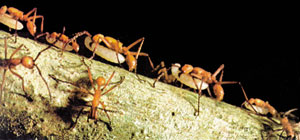 |
We mentioned that ants live in colonies and that a perfect division of labour exists amongst them. When we take a closer look at their systems, we shall also see that they have a pretty interesting social structure. It will also come to our attention that they are capable of sacrifice at a much higher level than humans are. One of the most interesting points is that – compared to humans – they do not know the concepts such as the rich-poor discrimination and the fight for power that are observed in our societies.
Many scientists, who for years have been doing extensive research on ants, have not been able to clarify the subject of their advanced social behaviour. Caryle P. Haskins, Ph.D., the president of the Carnegie Institute at Washington has this to say:
After 60 years of observation and study, I still marvel at how sophisticated the ants' social behavior is. …The ants thus make a beautiful model for our use in studying the roots of animal behavior.1
Some colonies of ants are so extensive with respect to population and living area, that it is impossible to explain how they can form a perfect order over such a vast area. Therefore, it is not easy not to concur with Dr. Haskins.
As an example of these large colonies we can give the species of ant, called Formica Yessensis, that lives on the Ishikari coast of Hokkaido. This ant colony lives in 45,000 interconnected nests over an area of 2.7 square kilometres. The colony, which is composed of approximately 1,080,000 queens and 306,000,000 workers has been named the "Super colony" by the researchers. It has been discovered that all production tools and food are exchanged in an orderly fashion within the colony. 2
It is very hard to explain how the ants have maintained this order without any problems, considering the vast area they are living in. We must not forget that various security forces are needed for enforcing law and maintaining social order, even in a civilized country with a low population density. And there is an administrative staff leading and managing these units. Sometimes, it does not become possible to maintain the required order without problems despite all these intense efforts. Yet in ant colonies there is no need felt for police, gendarmerie or guards. If we consider that actually the duty of the queens, whom we think of as the leaders of the colonies, is just to maintain the species, they do not have a leader or a governor. There is thus no hierarchy based on a chain of command amongst them. Then who is it that lays down this order and maintains its continuity? In the later chapters of the book we shall find answers to this question and similar others in combination.
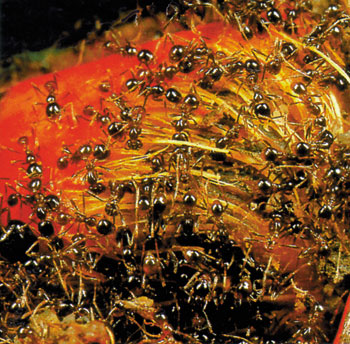 |
| The most important feature of ant colonies is their having a full "social life" and their doing everything as a matter of solidarity. In this picture, we see a group of ants that are trying to carry a fruit home together. |
Each ant colony without exception complies strictly with the caste system. This caste system consists of three major parts within a colony.
Members of the first caste are the queen and the males who make reproduction possible. More than one queen may exist in a colony. The queen has assumed the task of reproducing and thus increasing the number of individuals making up the colony. Her body is larger than that of the other ants. The duty of the males on the other hand is just to fertilize the queen. In fact, nearly all of these die after the nuptial flight.
The members of the second caste are the soldiers. These take on duties like the setting up of the colony, finding a new living environment and hunting.
The third caste consists of worker ants. All of the workers are sterile females. They take care of the mother ant and her babies; they clean and feed them. In addition to all these, other jobs in the colony are also under the responsibility of the workers. They build new corridors and new galleries for their nests; they search for food and continually clean up the nest.
The worker and soldier ants also have sub-groups. These are named slaves, thieves, nurses, guards and foragers. Each group has a different task. While one group focuses completely on fighting the enemy or hunting, another group builds nests, and yet another one looks after maintenance.
Every individual in the ant colonies does his full share of the work. None of them worry about the position it is in nor the nature of the job it performs, but it plainly does what is required of it. What is important is the continuity of the colony. When we think about how this system could have developed, we cannot avoid reaching the fact of creation.
Let us explain why: Where there is perfect order, logically we reach the conclusion that this has certainly been established by a planning mind. For instance, there is a disciplined order in the military; it is obvious that the officers in control of the army have established this order. It would certainly be an absurd idea to assume that all individuals in the army came together on their own and organized themselves and that later on they were grouped in different ranks and started acting in compliance with these ranks. Furthermore, the officers who have established this order have to keep on carrying out inspections of this order so that it may persist without any problems. Otherwise, an army left solely to the troops would soon be transformed into an unruly crowd, regardless of how well disciplined it might have been at the beginning.
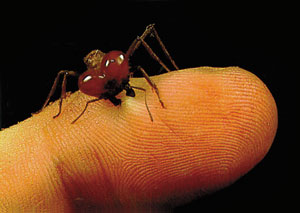 |  |
| Ants, which are very small creatures, pursue their lives with perfect orderliness in spite of their size. | |
The ants also have a discipline very similar to that of the military. Yet the critical aspect is that there is no "officer", that is any organizing administrator, in sight. The various caste systems within the ant colony carry out their duties in a faultless manner; although, yet there is no obvious "central power" which supervises them. Then the only explanation is that the central will in question is an "invisible" one. The inspiration which is mentioned in the Qur'an with the statement "And your Lord revealed to the bee" (Surat Nahl: 68), is this invisible power. This will has achieved such tremendous planning that people are in awe of it when they try to analyze it. Such awe and wonderment have been expressed from time to time in various forms by the researchers as well. Evolutionists, who claim that such a perfect system has developed as a result of coincidences, are not able to explain this sacrificial behaviour which is at the core of this system. An article written on this subject in the Journal of Bilim ve Teknik indicates this incapability once more:
A classical form of explaining the fact of sacrifice is that the colonies which are made up of individuals who are ready to sacrifice for the benefit of the group or the genus shall be more successful during evolution than those which are made up of egotistical individuals. However, the point, which is not explained in this theory, is how the societies which can sacrifice may maintain this characteristic. A single egotistical individual who may come up in such a society should be able to transfer its selfish characteristics to the later generations, since he is not going to sacrifice himself. Another vague point is that if evolution happens at the level of societies, what should the dimension of this society be? Should it be the family, species, genus or class? Even if there is an evolution simultaneously at more than one level, what will be the result when interests are in conflict?3
 | 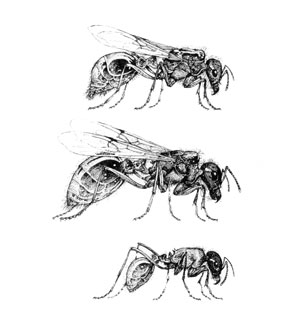 |
| Ants within the same colony who belong to different castes have different physical appearances as well. Each has a physical build appropriate for its job. | |
As we can see, it is not possible to explain the sense of sacrifice in living beings and the social systems based on this sense with the theory of evolution, that is, by assuming that living creatures have come into being by chance.
 |
| In these drawings, we see the doorman ants with their special shaped heads. |
When we analyze the details of the system in the ant colonies, we feel the power of the invisible will, which establishes and governs this system, in a more concrete way. Now let us take a look at these details.
The connections to the outer world of the ant nests are usually via a small hole large enough for an ant to go through. Passing through these holes is by "permission". There are ants within the colony whose numbers are not very many with the duty of "serving as a doorman". "The doormen" serve as living gates with the shapes of their heads fitting right in the nest entrance. Furthermore, the colour and design of their heads are the same as that of the tree barks in the close surrounding. The doorman sits for hours at the entrance hole and allows free passage only its nestmates.4
This means that the idea of keeping a doorman to guard the buildings has been put into practice, before men, by doorman ants, who cover the entrance with the strongest part of their bodies, who also camouflage themselves and who do not let in those who do not say the right "password".
It is quite obvious that that the head of the doorman ant that we mentioned above fits right into the hole, that its colour and patterns conform to the environment, and that it does not let in anybody that it does not know, cannot be up to its own will. There certainly is an owner of intellect who has designed the body of the ant in this form and who inspires the job it is doing. To say that the ant can figure out these duties on its own and serves as a doorman without running out of patience and without giving up, would certainly not be a sensible explanation.
Let us think: Why would an ant want to be a doorman? If it had a choice, why would it pick the job, which is the most cumbersome and that requires the most sacrifice? If it did have such a chance, it would certainly pick a job that would provide it with the most comfortable environment and the best service. The choice, in fact, has come about with the determination of Allah. And the doorman ant performs its duties in full obedience. Only the creator of the ants may have designed such a perfect colony life to show the striking side of His art and given particular duties to the ant colony which abides by this system. According to the theory of evolution, however, the ants should be developing in every respect and they should be trying to get into a caste where they could live a lot more comfortably. However, the doorman ants make no effort in this direction and they perform their inspired jobs faultlessly throughout their entire lives.
The organization, specialization in certain fields, and communications in the ant world is almost as successful as among human beings. This is true to such an extent that human beings are patterning their systems today on the harmonious system of the ants. The excerpt below illustrates this point:
Computer experts today are trying to reproduce in laboratories the collective behaviour forms of ants in robots. Instead of very advanced programmes, they are focusing on robots that cooperate devising between themselves on the basis of "simple" information elements. In these studies, the basic principle is the same. Instead of forming a highly advanced robot, the intention is to develop a herd of robots that are less "intelligent" but which will undertake the most "complex" tasks, just as the ants do in the ant colony… These robots will not be very advanced from the point of "intelligence" when taken one by one, but they will achieve the division of labour by collective action motivation. This will be possible because they will have the capacity to exchange the simplest information with each other. The life and cooperation in the ant colony has also influenced NASA… The organization is planning to send many "ant robots" for research on the planet Mars instead of a single advanced robot. Thus, even if some of them are destroyed, the surviving members of the team will be able to complete their tasks. 5
Let us now take a look at an interesting example from the world of "expert ants".
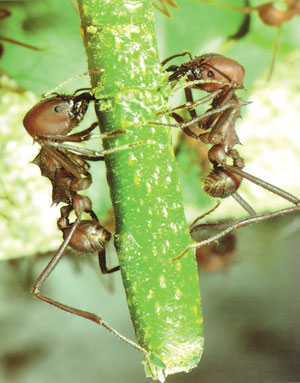 |
| Ants are beings that can only live in groups. They cannot survive alone. |
The most obvious example of cooperation among ants is in the behaviour of a worker ant species called Lasius emarginatus. The individuals of this species have interesting affiliations with each other. The activities of four worker ants belonging to the group that works with earth go on when they are separated from the big group. However, when there is a substance, like glass or stone in between which prevents them from seeing each other, their rate of work slows down.
Another example is that when the fire ants are separated from their groups by a thin barrier, they try to reach the other members of their colony by piercing this obstruction.
Many variations occur also in the behaviour of ants when the number of individuals in the group changes. When the number of ants in the nest increases, it is observed that the activity of each one of the individuals also proportionally increases. When the worker ants come together as a group, they get together, calm down and spend less energy. It has been determined that as the population increases in some ant species, there is a drop in the amount of oxygen spent.
What all these examples show us is that ants cannot survive on their own. These small creatures have been created with characteristics that allow them to live only in groups or even colonies. And this proves to us how out of touch with reality are the claims by the evolutionists with regard to the socializing process of ants. It is impossible for the ants to have been living alone when they were first created and to have socialized later on to form colonies. It would have been impossible for an ant facing such an environment to have survived. It would have had to reproduce, to build a nest for itself and its larvae, to feed both itself and its family, be a doorman, be a soldier and also a worker who took care of the larvae… We cannot claim that all these jobs requiring an extensive division of labour could have been performed once upon a time by a single ant or even a few ants. Furthermore, it is impossible to think that they worked hard towards socialization while performing these mundane tasks. What is deduced from all this is the following: Ants are creatures who have been living under a social system and in groups since the day they were first created. This in turn is proof that ants have come into existence in one single moment with all their characteristics intact and, if we wish to phrase it better, that they have been "created".
Say: 'Have you thought about your partner gods, those you call upon besides Allah? Show me what they have created of the earth; or do they have a partnership in the heavens?' Have We given them a Book whose Clear Signs they follow? No indeed! The wrongdoers promise each other nothing but delusion. (Surah Fatir, 40)
Let us expand a little the example of an army that we gave previously. Just think that you arrived at an army headquarters that is enormously large, but in which there is complete order. It looks as if you cannot go inside, because the security guards at the gates do not let in anybody they do not know. The building is protected with a security system that is strictly supervised.
Let us just assume that you found a way of getting in. Various systematic and dynamic activities will catch your attention inside, for thousands of soldiers are performing their duties in a strictly orderly fashion. When you search for the secret of this order, you notice that the building has been designed in a form entirely suitable for the inhabitants to work in. There are special departments for each job and these departments are designed so that the soldiers can work in the easiest manner. For instance, the building has floors underground, but the department which requires the sun's energy is located where it may get sunlight at the widest possible angle. And the departments which have to be in constant touch with each other are constructed very close to each other so that access would be facilitated. The warehouses where the surplus materials are stored are designed as a separate department in one side of the building. The warehouses where such requirements are kept are comfortable, accessible locations and there is a wide space right at the centre of the building where everybody may gather.
The features of the headquarters are not limited to these. The building is heated uniformly in spite of its vastness. The temperature stays constant all day long thanks to an extremely advanced central heating system. Another reason for this is the building's extremely effective external insulation against all weather conditions.
If the question of how and by whom this type of headquarters was designed was asked, everybody would say that it is by superior technology and by a professional team work. Such a headquarters building can only be built by people who have a certain level of education, culture, intellect and logic. However, this headquarters building is actually an ant's nest. To accumulate the required information to build such type of a headquarters building would take quite a long part of human life. However, an ant coming out of the egg knows its duty at that moment and starts work without losing any time. This shows that ants possess this information before they are born. All this information has been inspired in the ants at the time of their creation by Allah, the Almighty Who created them.
 |
| 1. Air Defence System: When the greatest enemies of ants, birds, approach the nest, some of the fighters turn their bellies upward in the opening of the nest and spurt acid towards the birds. 2. Greenhouse: In this chamber looking south, the eggs of the queen ant mature. The temperature of the chamber is constant at 38¡ C. 3. Main entrance and side entrances: These entrances are guarded by doorman ants. In time of danger, they close the doors with their flat heads. When other inhabitants of the colony wish to enter through the door, they tap on the doorman antÕs head with their antennae with a special rhythm and the doorman ant opens up the entrance. If they forget this rhythm, the guards kill them right there and then. 4. Ready-made chambers: If ants find an old nest where they build their nest, they also use those chambers of the old nest which have maintained their shapes. Thus, they gain significant time in completion of the structure 5. Storage cemetery: Ants put the non-consumed grain shells they collect and the bodies of other dead ants into these rooms. 6. Guards chamber: The soldier ants located here are in a state of alarm round the clock. When they sense the slightest danger, they swing into action. 7. Exterior insulation: This insulation, made up of pieces of branches and twigs, provides shelter for the nest against heat, cold and rain. Whether the insulation layer is decreased or not is constantly supervised by worker ants. 8. Nursing chamber: Nursing ants produce a sweet fluid from their abdomens. Raiser ants pierce their bellies by means of their antennae and utilize this fluid. 9. Meat depot: Insects, flies, crickets and enemy ants are stored in this depot after being killed. 10.Grain depot: Miller ants bring large pieces of grain in the form of small tablets here, to utilize them as bread in winter. 11. Childcare for larvae: Nurse ants use their saliva, which has antibiotic properties, to protect baby ants from disease. 12. Wintering room: Ants who hibernate, starting at the beginning of November and waking up in May, spend the long winter season here. When they wake up, they clean this room as their first duty. 13. Central heating department: Mixing of leaf pieces and twig bits here produces a certain heat. This keeps the nest temperature up to between 20 and 30 degrees. 14. Brooding room: Eggs of the queen mother are stored in this chamber in the order they are laid. Then, when the time comes, they are picked up from here and taken to the greenhouse. 15. Royalty room: The queen mother lays her eggs here. Assistants who continuously feed her and clean the chamber stay with her.6 |
There is no leader, planning, or programming in the world of ants. And the most important point is that there is no chain of command as we mentioned before. The most complex duties in this society are carried out without skipping a beat due to an immensely advanced self-organization. Consider the following example:
When food shortages occur in the colony, the worker ants are immediately transformed into "feeder" ants and they start feeding others with the food particles in their reserve stomachs, and when there is surplus food in the colony, they shed this identity and again become worker ants.
The sacrifice displayed here truly is at an advanced level. While human beings have not succeeded in fighting hunger in the world, the ants have found a practical solution to this problem: to share everything, including their food. Yes, this is a real example of sacrifice. Giving without hesitation everything it owns including its food to the next ant, so that it may survive, is just one of the examples of sacrifice in nature which the theory of evolution cannot manage to explain.
There is no creature on the earth which is not dependent upon Allah for its provision. He knows where it lives and where it dies. They are all in a Clear Book. (Surah Hud, 6)
There is no overpopulation problem for ants. While today, the metropolises of man are becoming hard to live in due to migration, lack of infrastructure, misallocation of resources and unemployment, ants can manage their underground cities, with a population of 50 million in a fantastically orderly fashion, without the feeling that anything is lacking. Each ant immediately adapts to changes occurring in its environment. For such a thing to occur, the ants must have certainly been programmed physically and psychologically. For the emergence of such extremely well organized systems, there has to be a "master will" to give them the inspiration to do their work and to give them orders. Otherwise, great chaos would ensue rather than order. And this master will pertains to Allah, Who owns everything, Who is Almighty, Who directs all living beings and orders them by inspiration.
 |
Worker Ant Fossil Term: Cenozoic Era, Oligocene Term There is no difference between 25-million-year-old winged ants and specimens alive today. Winged ants that have remained the same despite the passage of millions of years are some of the proofs that evolution never happened. |
The fact that ants perpetually strive without any consideration of benefit, is proof that they are acting on the inspiration of a certain "supervisor". The verse below fully confirms that Allah is the master and supervisor of everything and that every living creature acts on His inspiration:
I have put my trust in Allah, my Lord and your Lord. There is no living being He does not hold by the forelock and inspect! My Lord is on a straight path. (Surah Hud, 56)
 |
| In the first stage of nest building, members of the colony open a tiny hole, then expand into a labyrinth of chambers. In most of these sections, there are fungus gardens. These gardens fill the chambers, which are located near the surface. Larger, deeper pits hold decomposing plant detritus and waste. A few of these pits, oddly, contain more soil than organic matter, as if a soil cover is needed for especially noxious waste. Hot air rises from these refuse chambers. Cool, oxygen-rich air is drawn into the nest. Openings directly above the nest are used only for excavation and ventilation. Cavernous perimeter tunnels form a beltway some 7.5 meters from the nest. The most important point here is that this metropolis has been constructed by ants who have not taken any architectural or agricultural courses whatsoever. |
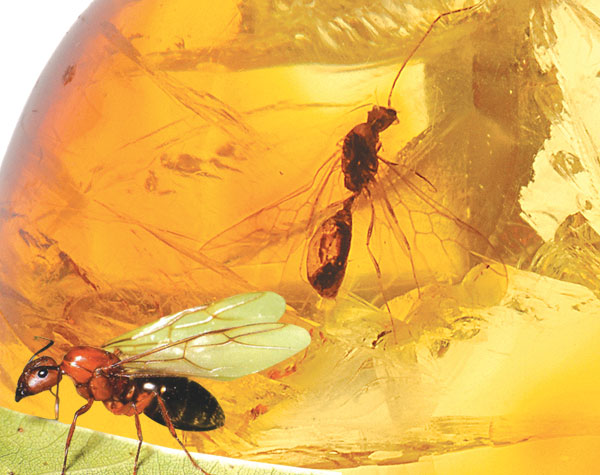 |
Winged Ant Fossil Term: Cenozoic Era, Oligocene Term Winged ants have two long wings 5 to 8 millimeters (1.9 to 3.1 in) in length. They build their nests close to sources of food and water. These ants have remained unchanged for millions of years. The fossil ant in 25-million-year-old amber shows that these insects have been remained the same for millions of years, in other words, they did not undergo evolution. |
1 National Geographic, vol.165, no.6 , p. 775.
2 Bert Hölldobler-Edward O.Wilson, The Ants, Harvard University Press, 1990, p. 1.
3 Bilim ve Teknik Dergisi (Journal of Science and Technics), sayı: 190, s. 4.
4 Bert Hölldobler-Edward O.Wilson, The Ants, Harvard University Press, 1990, p. 330-331.
5 Focus Dergisi (Focus Magazine), October 1996.
6 Focus Dergisi (Focus Magazine), October 1996.